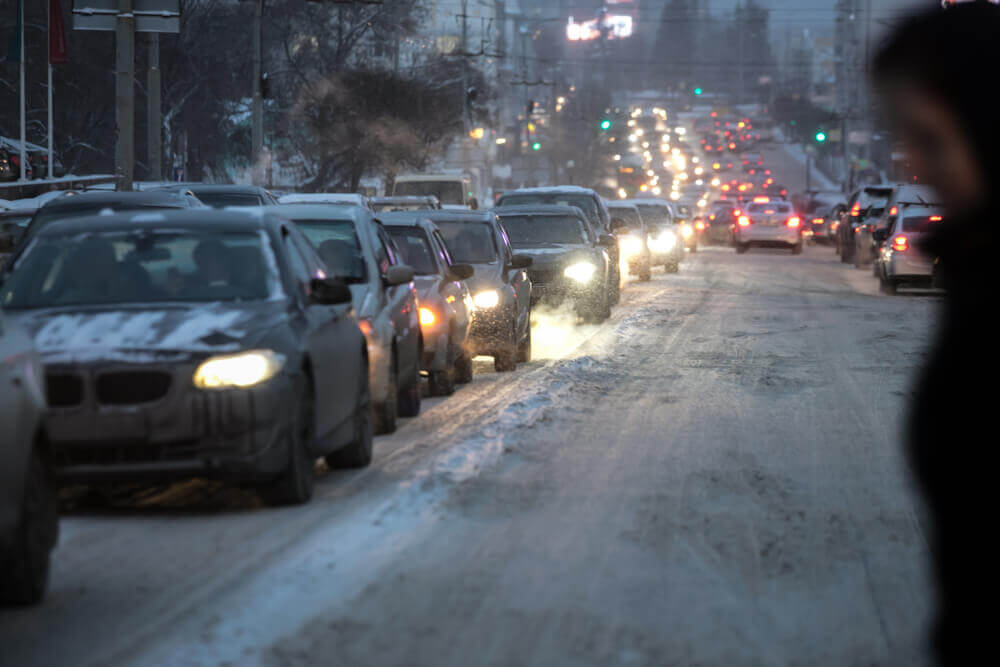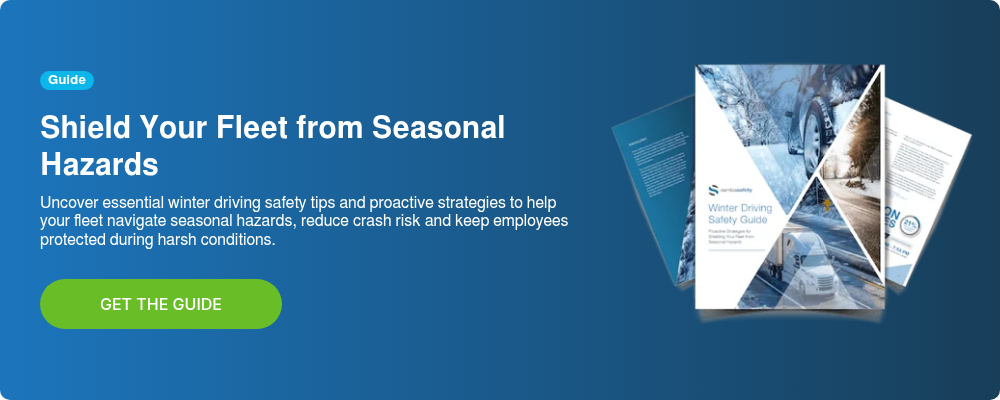Eye-Opening Winter Driving Safety Statistics and How Your Fleet Can Combat Them

While safe driving should be a year-round habit, company drivers must take extra caution during colder winter months. Even though drivers log 20% fewer miles in winter compared to summer, the number of collisions only drops by 5%, as bad weather and fewer daylight hours make the road even more dangerous.
Below, we’ve gathered a list of important winter driving safety statistics, as well as ways companies can strategize to ensure their fleets have the knowledge and skills to combat the risks this winter.
Download Our Free Winter Driving Safety Resources Bundle for Fleets!
Protect Your Fleet from These Winter Driving Safety Statistics
As we mentioned above, drivers tend to travel 20% less throughout the winter months. But even though these drivers are logging fewer hours, 20% of vehicle crashes still occur during the winter. Below are just a few of the many causes of winter driving crashes.
Dangerous Road Conditions
Each year, 24% of weather-related vehicle crashes occur on snowy, slushy or icy pavement, and 15% happen during snowfall or sleet.
Snow and ice greatly reduce pavement friction and vehicle maneuverability. This causes slower speeds, reduced roadway capacity, limited visibility and ultimately increased crash risk. Drivers must be aware of:
- Less traction between tires and the road
- Slower braking
- Challenges for climbing steep hills
When it’s “just” raining or when snow and ice start to melt, drivers tend to let their guard down. But while wet roads and rain may seem less dangerous than snow, 74% of weather-related incidents happen on wet roads.
Discover 7 Simple Ways to Winterize Your Fleet Vehicles
Increase in Drowsy Driving
Up to 20% of serious crashes are caused by drowsy driving. Just missing two to three hours of sleep can create the same impairment as being legally drunk.
One in three collisions occurs between 3 p.m. and 9 p.m. during the winter. This tends to be because the days are shorter, shifts are longer and fatigued drivers take chances they shouldn’t. The problem is so significant throughout the winter months that the National Sleep Foundation runs a drowsy driving prevention campaign every November.
Slip, Trip and Fall Incidents
During winter, long shifts and slippery surfaces magnify every mistake. Slip, trip and fall injuries are the #1 workers’ comp claim year-round, but they’re much more common in winter.
On average, a driver who has a slip and fall injury will miss 12 days of work, and during the busy holiday shipping season, you need all hands on deck. That’s why it’s important to educate drivers on how to avoid injuries in icy parking lots and slippery loading docks, in addition to avoiding hazards on the road. But where do you start?
Strategies for Combating Winter Driving Accident Statistics
You MUST take a proactive approach to combat winter driving accident statistics. The sooner you start preparing, the better. Consider implementing the following strategies in your risk management processes:
1. Create a Winter Safety Driving Policy
You need to start by setting a foundation to ensure each member of your fleet knows the company's rules surrounding winter driving safety.
You can do this by communicating winter driving safety policies and procedures. A winter safety driving policy should cover steps for drivers, supervisors and maintenance teams to mitigate risks during the colder months. This could include anything from pre-trip inspections and emergency supply recommendations to route planning and inclement weather protocols.
2. Provide a Winter Pre-Trip Inspection Checklist for Your Fleet Drivers
Preparing your fleet before the start of every journey is critical during the winter months. Fleet drivers must know what to check for and what to carry to navigate harsh weather conditions and handle emergencies.
You can prepare your fleet for the challenges of winter roads by sharing a winter driving pre-trip inspection checklist. This essential resource helps drivers prioritize safety and vehicle readiness by highlighting critical daily inspections, pre-trip preparations and emergency supplies. From ensuring proper tire tread and fluid levels to stocking up on survival gear and understanding winter driving techniques, a checklist can help your drivers navigate adverse weather conditions with confidence.
View an Example Winter Driving Pre-Trip Inspection Checklist Here
3. Implement Training Programs for Winter Driving
Winter-specific driver training programs are essential for equipping fleet drivers with the knowledge and skills to navigate challenging weather conditions. These programs go beyond general driving instruction by addressing the unique hazards of winter roads.
Your training should focus on defensive driving techniques, such as maintaining safe distances and safely braking in low-traction conditions. Drivers should also learn how to adjust to reduced visibility and recognize dangerous road conditions before they escalate.
Additionally, fleets can leverage technology to track driver behavior and violations, enabling a more targeted approach to winter safety training. By addressing specific risks and behaviors identified through telematics, motor vehicle records (MVRs) and other data sources, companies can tailor coaching and training efforts to individual drivers, making interventions more effective and avoiding the inefficiencies of blanket training programs.
4. Invest in Technology for Identifying Winter Driving Risk
As mentioned above, the use of modern technology is a powerful way for fleets to monitor and improve safety during the winter months and beyond. Tools such as MVR and CSA (Compliance, Safety, Accountability) monitoring provide valuable insights into driver compliance with legal requirements and help identify violations. For instance, if a driver receives a speeding ticket, these tools allow companies to respond with targeted training aimed at remediating the specific behavior.
However, not all risky drivers are caught by law enforcement. This is where telematics comes in. Telematics monitoring alerts fleets of dangerous driving behaviors such as speeding, harsh braking and other unsafe maneuvers, catching these unsafe actions before they escalate to violations. For example, if a driver habitually speeds in icy conditions or tailgates in poor visibility, telematics can detect these patterns in real time, triggering alerts and enabling companies to intervene with targeted coaching or training.
Create a Fleet Safety Plan that Combats Winter Driving Accident Statistics
Unfortunately, the winter driving safety statistics we covered above only scratch the surface of the dangers company drivers face while behind the wheel in the winter. From navigating black ice to battling holiday traffic on a tight schedule, drivers need to remain knowledgeable, attentive and vigilant in ensuring they are prioritizing the safety of themselves and others they share the road with during colder months.
Looking for more strategies, tips and resources for protecting your fleet from the heightened risks of winter? Download our free Winter Driving Safety Guide.




